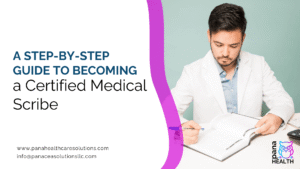Today, managing patients requires more than medical skills. Healthcare providers face a lot of issues with clinical documentation, record keeping, and administrative burdens while delivering care to patients. When juggling patient visits, back-office tasks create strain for patients. It leads to missed patient details and delayed reports that slow the workflow. The fragmented data and overwhelmed hospital staff hinder patient outcomes.
To overcome all these challenges, smart healthcare facilities invest in outsourcing medical transcription services.
Read the blog to explore how transcription services help to ease documentation workload and streamline operations in a healthcare setting.
What are medical transcription services?
Medical transcription services refer to the process by which audio recordings from healthcare professionals are turned into accurate, structured text by skilled transcriptionists. According to U.S.-based sources, this process involves professionals who understand medical terminology, procedures, and the documentation requirements of healthcare.
The transcriptionist listens to dictation, for example, patient history, operative reports, or discharge summaries, and prepares a written record suitable for integration into patient records.
The service may be done in-house, but many providers outsource to expert healthcare transcription firms to save costs and improve turnaround.
What does medical transcription include?
Healthcare transcription services cover various tasks to deliver a ready-to-use final text record. Key services include-
Patient Medical History
Preparing the clinical notes on patient background, examination findings, & initial assessment.
Consultation notes
Specialist reports are rendered after study or evaluation of a patient.
Operative reports
Detailed documentation of surgical procedures, findings, and post-operative instructions.
Discharge summaries
Preparing summaries of hospital stay, provided treatments, & discharge instructions.
Diagnostic test results/radiology/pathology reports
Transcription of narrative reports linked to imaging or laboratory studies.
Progress notes
Ongoing documentation of patient status over time.
Referral letters
Medical transcriptionists prepare letters that connect different providers & help coordinate care.
Quality assurance & editing
Medical documentation services also include proofreading & formatting a medical document. It ensures consistency, accuracy, & compliance with HIPAA guidelines.
By managing this variety of documentation tasks, transcription services provide structured, timely, accurate records that support clinical workflows and administrative needs.
How are Transcription Services Streamlining Healthcare Operations?
Let’s examine how medical transcription companies take pressure off healthcare teams and improve overall efficiency.
Frees up clinicians’ time
When doctors and nurses can dictate reports and rely on professional transcriptionists to convert them into text, they spend less time on paperwork. Studies show that clinicians spend up to 5.5 hours per 8-hour shift on medical documentation.
A medical transcription company allows them to focus more on delivering quality care and less on administrative burdens.
Enhanced Documentation Accuracy
Trained medical transcriptionists with familiarity in medical terminology can reduce errors caused by missing details or incorrect formatting.
Accurate records support better treatment decisions, reduce risks, and strengthen documentation for legal, compliance, and billing purposes.
Faster Turnaround
Outsourced medical transcription services offer faster delivery of records. It means healthcare providers can access patient information timely manner.
Quick availability of documents supports continuity of care & enables faster decision-making.
Cost efficiency
Handling an in-house transcription team involves hiring, salaries, training, providing equipment, and overhead. Outsourcing or using specialized services can reduce those costs.
Healthcare organizations can redirect resources to core clinical functions rather than administrative tasks.
Standardisation & consistency
When transcription follows defined templates and formatting rules, it produces uniform, searchable records. This supports integration with electronic health record (EHR) systems and retrieval of information.
Standardisation also simplifies audits, billing, and compliance.
Scalability and flexibility
Healthcare operations often face variable workloads, more patients, and more records. Transcription services can scale up or down depending on demand.
Such flexibility ensures that peaks in documentation do not create bottlenecks.
Compliance and security
Professional transcription providers are well-versed in U.S. regulations (for example, Health Insurance Portability and Accountability Act – HIPAA) and can manage secure file delivery, encryption, and specialist staff. Quantanite+1 This reduces the risk of data breaches, non-compliance penalties, and reputational harm.
Altogether, by handling documentation reliably, transcription services remove administrative load, support efficient workflows, and enable healthcare providers to operate more smoothly and focus more on patients.
Conclusion
Most medical providers in the USA face a dual work burden- delivering care to patients and managing heavy administrative work. The documentation process distracts providers and slows down the overall workflow.
Leveraging professional medical transcription services is the best way for providers to access detailed, accurate, and well-formatted records promptly.
In short, transcription services are a practical method for healthcare facilities to simplify operations and deliver patient-centered care.






